NOTES ON SOME MILITARY CALLS
By Captain C. R. Day Oxfordshire & Buckinghamshire Light Infantry
The use of musical instruments as a means of conveying Orders for military purposes, seems to date from very remote times. Probably they were first employed only as an incentive to the courage or the warlike feelings of those who heard them – or possibly to instil terror into the hearts of the enemy. But as time elapsed certain instruments, or even sounds, came to be employed during special movements, or before particular phases of the fight; and so their use gradually began to be constructed by the hearers as an equivalent for viva voce orders. In remote times, it is probable that the Jews made a similar use of trumpets and horns. Jewish historians have handed down traditional names of these instruments, and the Rabbis even at the present day cause the shophar, a curved ram’s horn trumpet, to sound certain traditional Calls in the Synagogue.
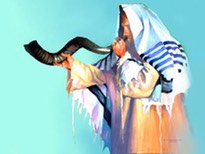
The shophar is the instrument mentioned in various parts of the Old Testament, and is to be distinguished, as a means of conveying signals, from the khatsotsrah, which was a straight trumpet, used for ceremonial purposes, and called also keren. It is somewhat unfortunate that these words should both have been translated alike by “trumpet” in our version of the bible. That the Greek and Roman armies made use of calls is very certain, not only for military but even for naval purposes. Xenophon, the historian, describes how the attack was sounded thus on board the Athenian fleet: the same writer mentions the use of the trumpet during the retreat of the Ten Thousand under Clearchus, which as a military achievement, would be considered wonderful even at the present day.
That regular Calls conveying commands, each distinct and easily to be recognised by the hearers, were employed, appears also to be certain; there are even stories of how an enemy was deceived by the device of a wrong Call having been sounded. Foremost amongst these is the account of how Pericles, the General commanding the Athenian forces at the siege of some seaport town, caused a few trumpeters to sound the attack from the wrong quarter. The besieged believing then that a surprise was imminent, hurriedly made a sortie from another gate, and thus allowed Pericles to take possession with ease. A somewhat similar story is to of Alcibiades.
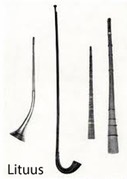
It is, however, in the Roman army that the use of military Calls really developed. In the time of Julius Caesar, which we may assume to be the period at which the Roman army was at its best, there were three instruments commonly employed: they were the lituus, the tuba and the buccina or cornu. Of these the former was in use in the mounted services, the two latter in the infantry: the tuba, or straight trumpet, being for ceremonial purposes, while the buccina or cornu was employed for manoeuvring.
The cavalry trumpet – the lituus – varied in length, ranging from 2 feet 6 inches to as much as 4 feet 6 inches. In form it was straight as far as the bell, which was turned upwards, somewhat like a bowl of a tobacco pipe in fact.

The tuba (Ophicleide) was perfectly straight, and the buccina or cornu, which was curved, tapered very gradually and had a long conical bore. When is use the buccina encircled the player’s body, the bell resting on his shoulder; a modern circular bass is held in a somewhat similar manner.
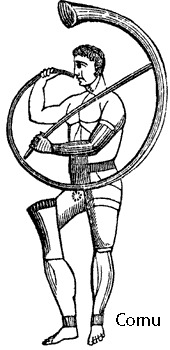
It is probable that the cornu, as it name implies, was first made from a cow’s horn, the form being subsequently copied in metal, and altered from time to time until it took the shape described.
Various specimens of these instruments in good preservation have been discovered, and from their construction were all evidently well capable of sounding calls. The mouthpieces were carefully made and resembled those of the modern trumpet, the cup was shallow, the rim flattish, and the orifice small: the mouthpieces were usually of metal and not detachable.
Sometimes a stay from the spring of the bell to a point below the mouthpiece strengthened the buccina. There are two cornus now in the British Museum, and, in 1890, at the Royal Military Exhibition, there was to be seen a replica of a larger one found near Naples. From military writers under the Roman Empire we learn that each regiment had its complement of trumpeters, and some of the Calls in common use are described. The historian Ploybius (B.C. 204), who, though a Greek, held a cavalry command in the Roman service, informs us that Reveille was sounded, also that there was a Call for Guard-mounting. Probably the employment of Calls for manoeuvring troops in the field was considerably extended during the centuries following, for Pollux, writing in the 2nd century of our era, mentions that the trumpet was either straight or curved, and that it was invented by the Tyrrhenians, and was made with a bone mouthpiece.
There was also an officer called buccinator principalis whose duties were probably somewhat similar to those of our Bugle Major. Pollux speaks also of Calls for the halt, the advance, and retire, also for encouraging the troops during the fight, and of a special sound for ceremonial or during sacrifices. Vegetius, who wrote a work entitled An Epitome of Military Institutions in the time of the Emperor Valentinian, about 390 A.D., gives more detailed accounts of the same nature. We learn that there were then Calls for the attack, or advance, for the halt, and for the retire.
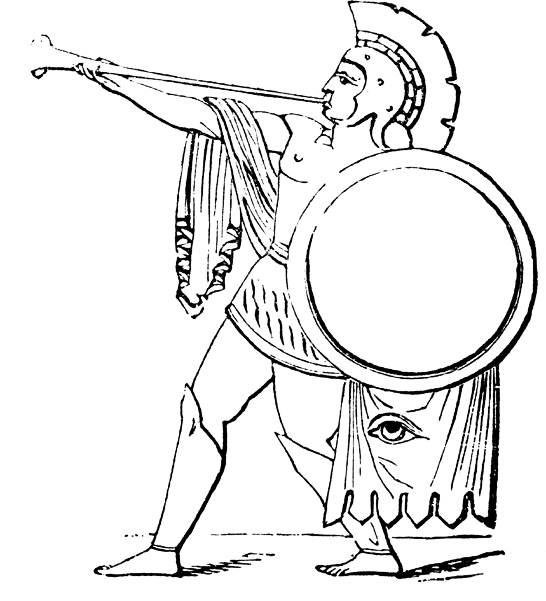
The classicum was another Call, only sounded when the General was present, or at some high ceremonial parade, or when a soldier was publicly punished. Other calls were doubtless employed, the uses of which are only hinted at. That the Roman trumpeters sounded their Calls with a particular style of their own – just as buglers of English regiments do at the present time – is also certain. Livy tells us how Hannibal the Carthagenian commander, tried to get possession of the town of Tarentum trumpeters to deceive the Roman troops by sounding a Roman Call, but as the style in which this Call was sounded was different, the Roman troops knew immediately that it was not sounded by one of their own trumpeters, and were consequently not deceived by it.
It is somewhat curious to note that the drum does not seem to have been used in the Roman armies for signalling purposes, but only as an adjunct either to increase the noise of battle, or for ceremonial purposes. The use of drums was adopted after Eastern conquests and during the decadence of the Roman Empire.
Passing to more modern times, perhaps the earliest evidence of the use of the trumpet in action is in the 13th century, when the French charge at was sounded at the battle of Bouvignes in 1215. From about this time trumpet-calls appear to have been used pretty generally throughout Europe. The earliest Calls in notation which we know of are contained in Jannequin’s La Bataille, published in Antwerp in 1545, and Pere Mersenne, who wrote in 1635 (Harmonie Universelle, Paris), also gives some most interesting Calls in notation. These calls are of course those in use at the time in the French cavalry. Mersenne gives eleven in all.
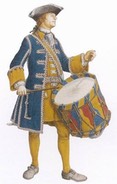
But the drum as well was evidently used in the French service, for the Seigneur de Courbouson, writing in 1610 (La Milice Francoise), advocates the use of a drum by each company, and remarks that the French drumming is superior to any other. The use of the drum for signalling purposes appears to have been originally adopted in Italy, for Machiavelli in his Art of War (written for Lorenzo de Medici in 1521) states very definitely that the drum was used to make the orders of the officer commanding known to the troops. Probably other European nations adopted this use of the drum from the Italians.
It is probable that in England also the drum was used in the infantry, and the trumpet in the cavalry; for in the Rules and Ordynances for the Warre, published for the French Campaign of 1544, we find some references to trumpet-calls: -
“After the watche shall be set, unto the tyme is be discharged in the mornynge, no manner of man make any shouting or blowing of hornes or whisteling or great noyse but if it be trumpettes by a special Commaundement. Every horseman at the fyrst blaste of the trumpette shall sadle or cause to be sadled his horse, at the seconde to brydell, at the third to leape on his horse backe, to wait on the King or his lorde or Capitayne.”
In A Complete System of Camp Discipline (2nd edition, London, 1757) mention is made of a regulation for garrison duty in 1694, in which certain Calls, i.e. Reveille, Assembly, &c., are beaten by the drummers, and there is a list of the meanings of different drum signals in 1748, then disused. In the many military works published during the 16th century we find either descriptions of, or allusions to, various Calls in use. In Markham’s Five Decades of Epistles of Warre (London, 1622) the Drum Calls are thus described:-
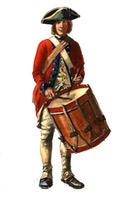
“First in the morning the discharge or breaking up of the watch, then a preparation or summons to make repair to their columns; then a beating away before they begin to march; then a march according to the nature and custom of the country (for it divers countries they have divers marches) then, a charge, then a retrait, then a troupe, and lastly a bataillion or battery, besides other sounds.”
Speaking of trumpet calls, the same writer says:- “The first point of warre is Butte sella, calp on your saddles; Mounte Cavallo, mount on horse backed; Tacquet, march; Carga Carga, an alarme to charge; a la standardo, a retrait or retire to your columns; Auquet, to the watch or a discharge for the watch, besides other points as Proclamation, Calls, Summons, all which are most necessary for every souldier both to know and obey.” Elton who wrote in 1650 (Complete Body of the Art Military), goes a little more into detail, and thus describes the duties of a private soldier:-
“He must inform himself of all the several beats of the drum, as first of a Call, second a troup third a march, fourth a preparative, fifth a battle or charge, sixth a retreat, and also of the Revally and the Tattoo.
By the first he is summoned to hear present proclamation, or else commanded to repair to his colours. Upon the beat of the second he is to advance his armes, and to close rank in rank and file to the distance of order, and to troup along unto such places and services, as he shall be commanded unto.
Upon the hearing of the third he is presently to shoulder his armes and to take his distance of six foot in rank, or three foot in file; upon the fourth he is to close both in rank and file unto the fighting distance, which is called order, and to press on himself for skirmish.
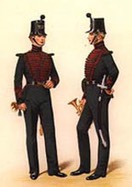
Upon the beat of the next, he is undauntedly to move forward, steping in good order into the place of his fellow souldier that shall happen to fall down dead before him. Upon the beat of the last he must orderly fall back either for reliefe, or advantage of ground, or other polliticall endes whereby he may draw the enemy into a snare. The first of the remaining two gives warning in the morning for some of the sentinells to fall off, or to be taken in; the latter is used in the night to give notice unto the souldiers or others for then repairing to their severall guards, watches, and lodgings.”
During the last century considerable changes were made in the English army owing to foreign influence and association with foreign allies, and there are several orders dating from the times of the Georges, relative to the duties of drummers. By the order of George II in 1743, “all horse and dragoon grand guards are to sound trumpets and beat drums, at marching from the parade and relieving.” When Light Companies were first formed in infantry regiments, they, in common with the rest of the army, used drums, and it was not until about 1790 that they adopted the bugle, the first official mention of which occurs in the Rules and Regulations for the Formations, Field Exercise, and Movements of His Majesty’s Forces, June, 1792.

The bugle in its original form was curved, and in shape exactly like that in the regimental badge.

This curved horn, made in metal, was doubtless in general use as early as the 13th century. There are specimens of horns of this date in the possession of the Corporation of Dover and Canterbury; they were called Burgmote horns and were used for military purposes. The “horn” in course of time for portability came to be constructed with a bend like the trumpet, and the bugle in this form remained in use until about 1840, when one with two turns, known as Captain Bridge’s bugle, made its appearance and was, after the Crimean war, definitely adopted. The earliest bugles were in C, and the Bb instruments were not adopted until comparatively recently.
Probably when the bugle was first used for military purposes, each regiment had its own separate Class, which were arranged according to the fancy of the commanding officer. These Calls were probably borrowed from Continental armies and modified to suit the regiments of our own service.
The first official collection of trumpet and bugle sounds was issued in December 1798, and by an order dated November 1804, these sounds were adopted throughout the army. A work, now vary scarce, entitled The Bugle Horn Major’s Companion, published in 1815, gives the regulation signals with barrack, field, and other useful sounds for the “movements of light infantry and rifle regiments.”
A comparison of this work (and of subsequent English collections of bugle sounds) with Calls used in the army of Piedmont early this century, leads one to suppose that most of our Calls were taken from the Italians, whose light infantry or Bersaglieri have from time immemorial been famous. The Bugle Horn Major’s Companion gives a good many Calls, such as the Rouse, Reveille, Dress, Assembly, Drill, Officer’s Call, Serjeant’s Call, Bugler’s Call, Setting of the Watch, 2nd Post, &c., which are identical with those now in use. The Call still used in our 1st Battalion for Left markers is founs (being called Formed Company), also the Calls for Advance, Flank, and Rear Guards.
The Reinforce now used by us is almost identical with the Detach Skirmishers; and the Extend, Incline, Advance, Retire, Close, Quick, and double, are as now used. Each company had a separate Call, but these consisted of but single or at most two notes.
“On the Detach Skirmishers being sounded the party ordered for that service marches out the specified number of paces, and forms in skirmish order. On the Skirmisher’s may Engage being sounded by the commanding officer’s bugler, the bugler with the skirmishers then sounds to commence firing, if necessary. The same to be observed in the formation of the Chain. To fire in extended order on the spot. So soon as the fire has sounded, the rear rank men take a side step of 10 inches to the right, and both ranks fire alternatively in this position, commencing with the front rank, each making ready when he hears the ramrods of the rank which has fired, working.”
From the detail given, when the Incline was sounded, the men apparently made a whole turn, instead of a half turn, as is now the case. The modern Wheel was called Right Shoulder Forward.
“At the signal to commence fire, immediately followed by the signal to retreat, the front rank fires, goes to the right about, marches in double time 24 paces to the rear of the rear rank, fronts and loads: the rear rank hearing the ramrods of the front rank working, makes ready, fires, then faces to the right about, marches in double time 24 paces, and the rear of the front rank ranks parts and loads, in this manner both ranks retire supporting each other.”
There were also Calls Interrogative, Negative, Affirmative, also Calls for signalling as to what the enemy consisted of, their movements, and even formation. By such means a sort of conversation could be carried on by means of buglers.
Curiously enough there is no mention of Retreat: neither is any Call of this name found in the official Infantry Bugle Sounds, published January, 1860. But in the Trumpet and Bugle Sounds for Mounted Services of January, 1870, the Retreat to be sounded on the bugle appears in the form we are accustomed to hear daily.
It would be interesting therefore to learn when the practice of sounding retreat with the bugle became officially recognised: it certainly was sounded by drums and fifes, early last century, and in the Rules and Articles, &c., of George I in 1718, we find “every soldier shall repair to his quarters at the beating or sounding retreat.” It is very probable that our present Retreat was adopted from Germany, for the identical Call was used in 1821 in the Hanoverian service, and as the Kings of England, for nearly a century, were also Electors or Kings of Hanover, it is not surprising that other Hanoverian Calls were identical or nearly so with our own. A similar resemblance cannot be traced in those of Prussia, Austria, or Bavaria; and still less in those of France or Belgium.
Again, sounding Tattoo appears to be very old custom, for in Count Mansfield’s Directions of Warre, published in 1624, mention is made as to how the drummers must “at night beat Tapto before the patrole goe about.”

This article first appeared in The Military Musician published at The Royal Military School of Music in October 1934
